Menu
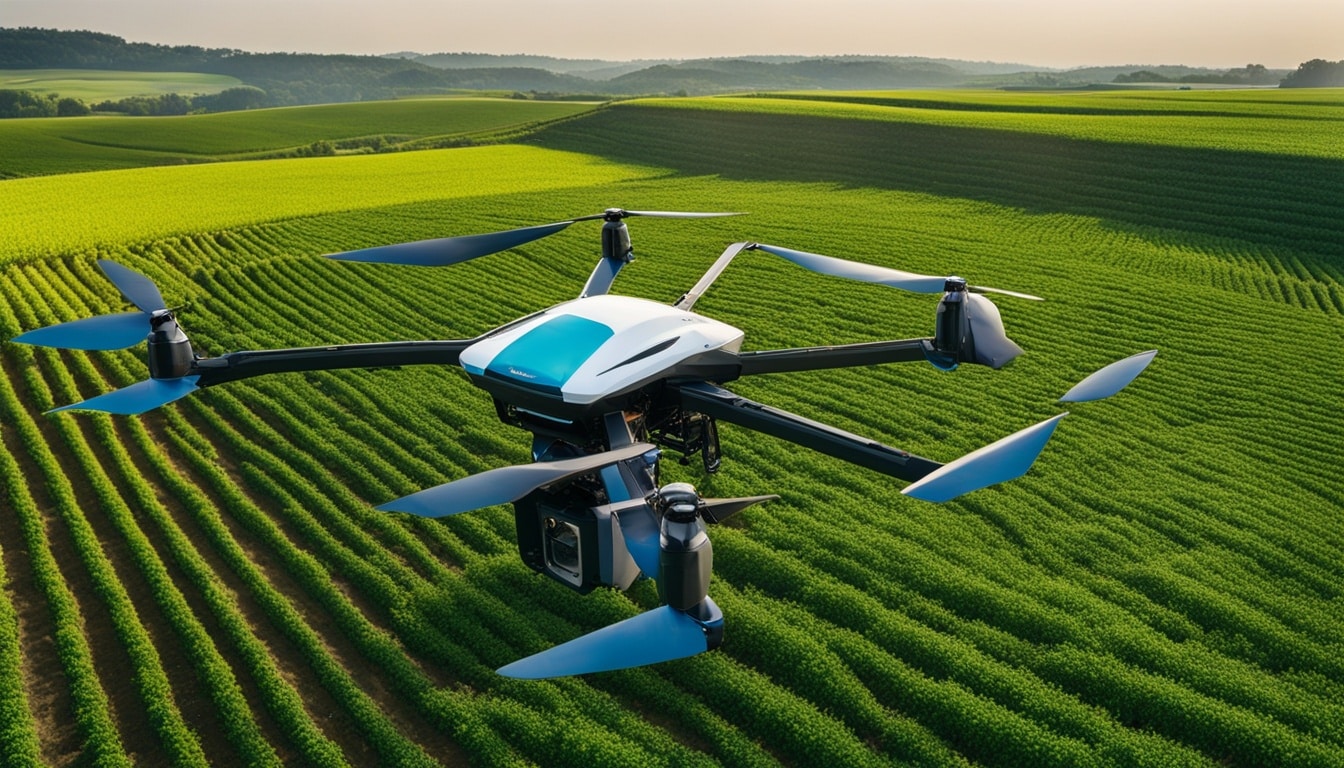
Over 59,000 employees from Syngenta are leading the way in cross-industry agricultural collaborations in over 100 countries. This number shows how important partnerships are in agriculture today. The recent VISION Conference in Glendale, Arizona, highlighted these joint efforts.
The Shoots by Syngenta project is a great example of this commitment. Syngenta, along with IBM Research and Maxygen, is using predictive models and protein evolution. Their goal is to tackle big agricultural challenges sustainably while embracing new tech innovations.
Major sponsors of the VISION Conference included Corteva Agriscience, AquaSpy, MentorMate, Ever.ag, Raven, and Publicis Sapient. These companies showed how vital collaboration is in the agricultural field. They introduced new tech, discussing topics like data quality and AI in farming.
The event also highlighted the importance of getting and keeping young people in agriculture. It stressed that by working together across industries, the sector can move forward. The conference intends to encourage the next wave of agricultural leaders, equipping them with the required tools and connections for success.
Modernising agriculture with technology is crucial, not just because it’s a trend. It’s a must because the world’s population is growing fast. By 2050, we’ll have 3 billion more people needing food. This makes working together on new agricultural technologies vital for sustainable food production. These new tools help farmers use resources smarter, increase how much they grow, and do less harm to our planet. This turns dreams of sustainable farming into real possibilities.
Agritech is changing farming, making it better in many ways. Precision agriculture, for example, uses data to make farming more efficient. GIS software helps by showing farmers things like how the weather is changing and if the plants are healthy. This means they can grow more food and solve lots of farming problems. Drones are also very helpful. They gather accurate information on crops, which cuts down on work and boosts productivity. These new tech tools are now key in making farming successful today.
Tech is essential for keeping farming sustainable. IoT tools let farmers check on plant health, control nutrients, and look after soil properly. They also can keep an eye on animals with RFID, making sure they stay healthy. A big example is the work IBM Research and Syngenta do together. They use AI to make better chemicals for farming, which makes things more efficient and greener.
Tools like EOS systems help with things like predicting how much crops will yield and what kind of crops they are. This, plus farm management software like Odoo, makes planning and monitoring farms easier. Thanks to these types of tech, farms are producing more and working towards being kinder to the environment.
Recently, working between different sectors has changed agriculture a lot. It has brought big progress through combined efforts in farming. These efforts bring new ideas and also help farming become more eco-friendly. The success of these projects can be seen through Syngenta Group’s partnerships.
Syngenta joined with IBM Research and Maxygen, showing the power of working together. Their work with IBM used special software to improve making chemicals. It made it easier to predict how different mixes of substances would react. This highlights how teamwork pushes agricultural tech forward.
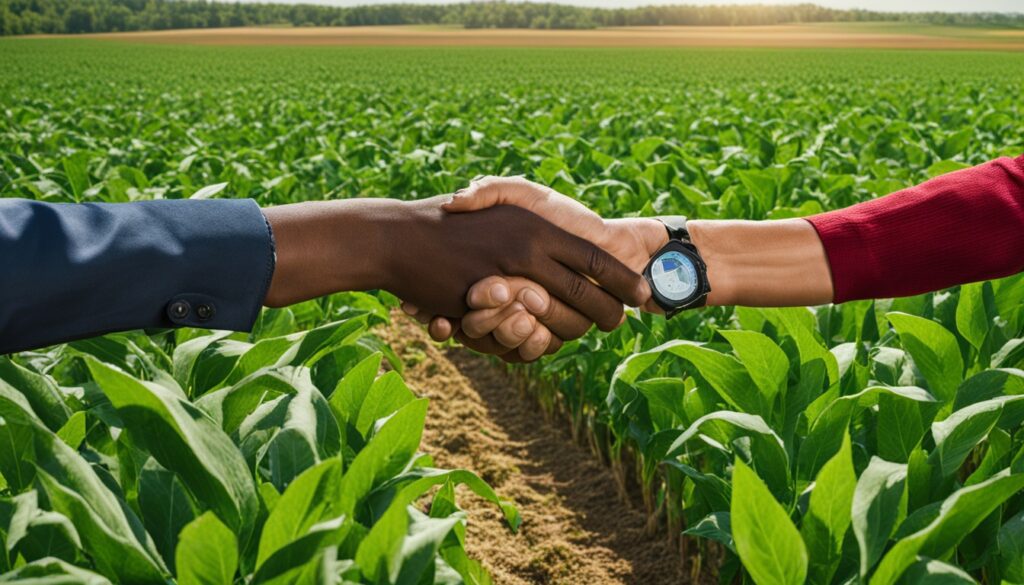
With Maxygen, the goal was to make better protein technology by evolving proteins directly. This brought about new protein types that work even better. It shows how powerful it is when different areas of science team up, leading to big breakthroughs in farming.
The VISION Conference in Arizona linked people from various areas for agriculture solutions. It was a meeting place for minds focused on tech in farming and the challenges each sector faces. Leaders from Ever.Ag, AquaSpy, Corteva, and AWS pointed out how crucial working together is in tech for food.
Brian Lutz talked about finding ways many sectors can help each other at the conference. AquaSpy’s Kathleen Glass set up a challenge on how to better use tech in farming. Such joint efforts make connections stronger and spread knowledge. The event also showed the need to bring in new, young talent to continue innovating. This supports how industry partnerships are key to agriculture’s future.
Satellite technology is changing agriculture by making farming more efficient, productive, and good for the planet. It needs farmers to work with scientists, engineers, and other experts to get the most out of it.
Satellite remote sensing is a big help in spotting pests early. This could keep up to 0.8 billion tonnes of crops safe every year. It also means we might use fewer harmful chemicals, cutting 50 million tonnes of CO2 each year.
Better ways of watering with satellites might use 5-10% less water, saving up to 2.8 billion litres. Monitoring food supply means we waste less and create an extra $150-175 billion in value. For farmers, saving just 5% on costs could be worth $7-8 billion, making satellite tech a smart investment.
Satellite tech is really changing farming. A recent report by McKinsey & Company found lots of farmers in the US are using it or planning to. This trend, growing by around 10% each year, could see the farming satellite market hit $1 billion by 2030. Most farmers using these tools are young, under 44, showing a big change in how farming is done.
Special technologies like GIS, RS, and GPS help map and study farms in detail, making sure we use resources wisely. For example, satellites and drones take detailed pictures to check soil, crops, and water. This helps farmers detect plant problems early and make smart choices.
Precision farming in the US is a great example of how satellites can boost production while using less water and chemicals. These success stories are paving the way for a greener, more profitable future in farming.
The use of AI and big data is changing farming. It makes processes better and boosts how much food we grow. For example, IBM and Syngenta are working together using smart technology. This work makes chemical use in farming smarter, helping fields produce more without wasting resources.
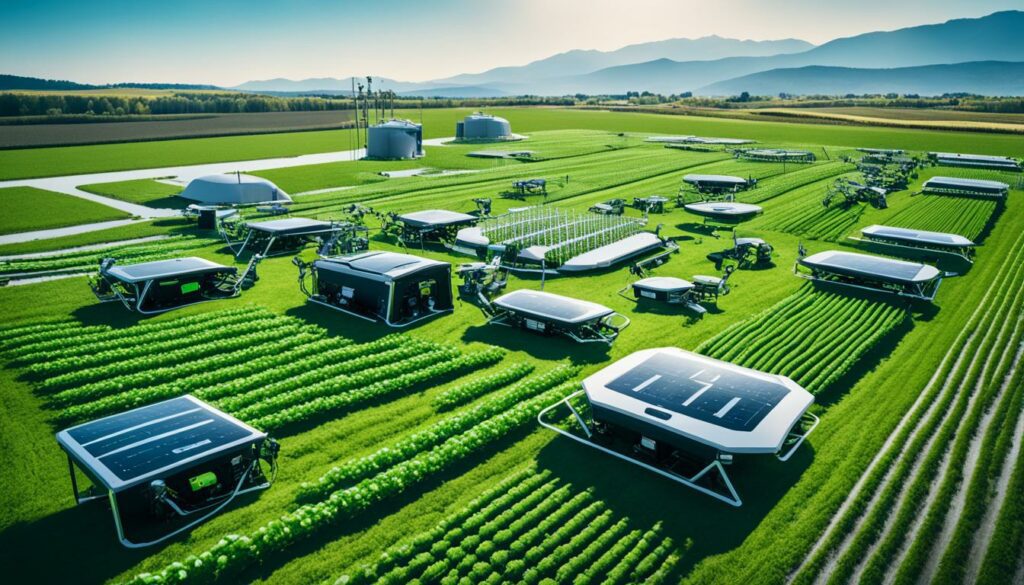
IBM-RXN is showing how AI changes agriculture for the better. With smart language models, scientists can make chemicals needed in farming accurately. This tech is key for farming to keep going strong, even with lots of new data every day.
Looking at farm data is very important. AI helps make smarter decisions in farming. At UC Davis, experts are using AI to make tomatoes better and safer. This is a great way to use the latest tech in a practical way.
The Artificial Intelligence Institute for Next Generation Food Systems (AIFS) is helping a lot. Thanks to the U.S. Department of Agriculture’s National Institute of Food and Agriculture, it has started many projects. These projects aim to make food systems better at every step. Connecting data with AI is key to making farms more effective and productive.
Start-ups and small tech firms are changing agriculture. They bring new solutions to the challenges farmers face. Thanks to a friendly start-up environment, this change is happening fast. Over 2500 agri-startups are now part of Startup India.
Many initiatives support these start-ups. There are Technology Business Incubators (TBI) and Agribusiness Incubators. These come under different schemes and organisations, helping start-ups grow.
As of November 10, 2021, more than 1.73 lakh ventures are registered with Startup India. Of these, 58,650 ventures are recognised by DPIIT. There are 7241 agri-startups, showing how important they are in agriculture today.
Since the past decade, over 80 start-ups have reached a unicorn status, each valued at over $1 billion. In 2021, 38 more start-ups joined them. These start-ups, led by young professionals, bring fresh ideas to farming.
Every year, 45,000 students graduate from 75 agricultural universities. It’s key to teach them entrepreneurial skills. This prepares students to start their own agri-businesses effectively.
In 2020-21, the agricultural sector made up nearly 20% of the GDP. There’s a lot of room for start-ups to grow. Investment in agricultural venture capital is also rising.
Start-ups and small tech firms drive innovation in agriculture. They find new ways to make the value chain more efficient. This is key as 33% of the initial production gets lost in the chain.
By 2050, the world’s population will hit 10 billion. So, the work of technology start-ups in farming is critical. They make farming more efficient and sustainable.
The AgTech investment field is growing quickly. From 2010 to 2015, investment more than doubled. This growth is like what we’ve seen in FinTech. It offers a big market and attracts many investors.
This support for agriculture start-ups is essential. It’s not just promising but also vital for the future. It ensures global food security and sustainable farming.
| Metric | Details |
|---|---|
| Registered Agri-Startups with Startup India | 2500+ |
| Technology Business Incubators under NIDHI scheme | 7 |
| Agribusiness Incubators (ICAR) | 50 |
| Agribusiness Incubators (State Agricultural Universities) | 29 |
| Venture Registrations with Startup India (as of 10 Nov 2021) | 1.73 lakh+ |
| DPIIT Recognised Startups | 58,650 |
| Total Agri-Startups | 7241 |
| DPIIT Recognised Agri-Startups | 2605 |
| Startups in Food & Beverage Industry | 2594 |
| Startups Valued Over $1 Billion (2011-2021) | 80+ |
| New Unicorns in 2021 | 38 |
| Annual Agricultural Graduates | 45,000+ |
| Agricultural Sector’s Share in GDP (2020-21) | Almost 20% |
Sustainable agriculture needs many people to work together. At big events, these people meet to talk about farming problems. They share new ideas and plan for the future of farming.
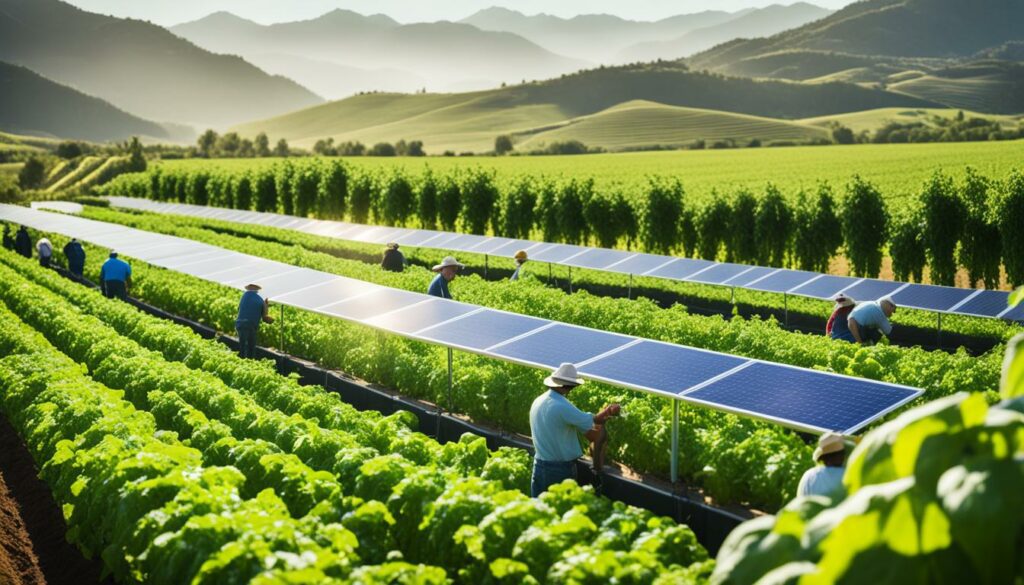
Maxygen is a leader in making farming eco-friendly. They improve farming by changing how proteins work. Working together with many sectors, they have made farming better. People talked about their new way of farming at an online event in June 2021.
Looking at biomass can make farming more sustainable. Meetings in St. Louis and Oak Brook underlined this. They showed how turning waste into resources can help the planet.
| Event | Location | Date | Key Focus |
|---|---|---|---|
| Plenary Meeting | St. Louis, Missouri | June 2023 | Cross-Sector Dialogue |
| Dialogue on Climate Action | Washington, D.C. | September 2019 | Climate Mitigation Strategies |
| Regenerative Agriculture Goals | Virtual Event | June 2021 | Equity and Inclusion for BIPOC Farmers |
| Circularity in Agriculture Supply Chains | Virtual Event | October 2022 | Closing the Loop in Supply Chains |
Technology is changing farming, making it possible to grow more food. Farming with advanced data and AI helps boost farm productivity and guards the environment. This means farmers can grow more food while using fewer resources.
Modern farming can use data to improve how crops grow. With high-tech tools, we can spot plant problems early, saving huge amounts of food. These tools also cut down on harmful chemicals, which help the planet. They even make water use smarter, saving millions of litres of water.
These new methods can also cut down on food waste. This could add billions of dollars to the economy each year. Plus, it saves money for the farmers, which is a big deal.
AI helps farmers keep a close eye on their crops and make better choices. About 29% of traditional farmers and 45% of those growing special crops already are or plan to use these technologies. They’re finding ways to use these tools, especially younger farmers.
By looking at old and new images, AI learns to predict what will help crops grow better. Projects like “Shoots by Syngenta” bring smart minds together to use data and tech in farming. Working together like this, and with a focus on the future, we can make farming better for everyone.
Recently, many big farm businesses and companies have turned to regenerative farming. They see it as key to greatly improving soil and looking after the environment well. Leaders in this include PepsiCo, Walmart, and General Mills.
Good soil health is vital. Healthy soil helps farms cope with tough weather. PepsiCo plans to use regenerative farming on 7 million acres by 2030.
General Mills also wants to improve one million acres the same way. They know healthy soil is the core of a strong farm. Grupo Bimbo helps farmers switch to better farming techniques on a large area too.
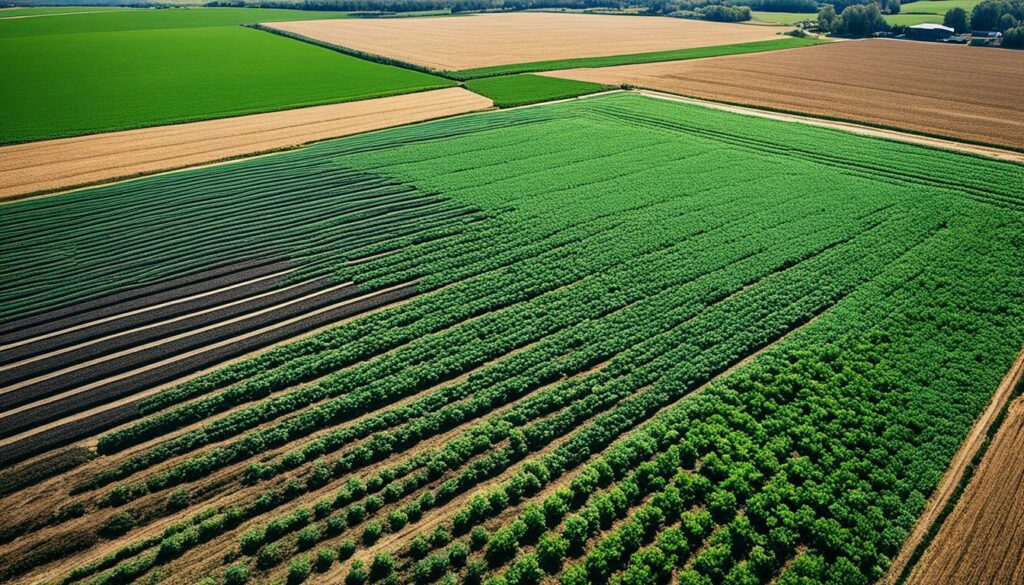
Reducing the harm to our planet is a main goal too. VF Corporation wants to cut the CO2e they produce by a million tons. They’re focusing on making cotton in a better way.
Big money is also being put into these green changes. Unilever, AXA Climate, and Tikehau Capital promise to spend €1 billion together. They aim to speed up the shift to greener farming practices.
Working together is crucial for this change. The Regenerating Together group sees over 30 farmers, companies, and others aiming for a global green farming standard. Nestle, Danone, and Unilever are part of this too, showing they’re all in for better farming practices.
| Company | Commitment |
|---|---|
| PepsiCo | 7 million acres of regenerative farming by 2030 |
| Walmart | 30 million acres in the Midwest |
| VF Corporation | Eliminate 1 million metric tons of CO2e by 2026 |
| General Mills | 1 million acres by 2030 |
| Grupo Bimbo | 14,800 hectares of sustainable farming |
| Unilever, AXA Climate, Tikehau Capital | €100 million each towards regenerative agriculture |
The changing climate can make farming harder by up to 30%. Regenerative farming is a green solution for this challenge. It helps farms become more durable against tough conditions. Involving farmers, scientists, and non-profits is key to make the world’s farming more green.
Agriculture technology’s future is tied to cross-industry teamwork, offering big changes. The Regenerating Together programme is a great example. Over 20 top FMCG companies and farmer groups joined hands. They’ve created and tested a worldwide plan for better farming across supply chains. This work is about real change on farms and moving towards sustainable farming everywhere.
The SAI Platform, with its 170 members, including names like Nestle and Danone, supports this global effort. They see how important these collabs are in fighting climate change. The threat of 30% less farm output due to climate makes tech in farming more critical than ever.
Being ready for climate challenges is key. The Regenerating Together program focuses on water, soil, biodiversity, and climate. It shows how to do farming that’s good for the environment. Farmers follow four steps: check risks, pick goals, adopt good ways, and keep checking the progress. This careful plan shows how cross-industry work deeply changes farming.
McKinsey & Company’s latest report says big changes are coming in the next two years in farming. This is thanks to new green opportunities and strong business models. This could lead to more joint efforts, seen at COP28, where companies planned to cut emissions together. The Value Change Initiative is a good example, helping such partnerships with funds and benefits.
Especially by 2024, more money will go towards helping nature, water, and ecosystems by food firms. But, one big issue is the need for better data for smarter supply chain decisions. Good, specific data can help turn ideas into big actions, pushing collaborative agricultural efforts forward.
So, moving ahead, cross-industry teamwork will keep being a key player in solving farming’s big issues. It’s vital for companies from all sectors to come together. This way, they can think up new ideas and make farming better. Our goal is a food system that can stand the test of time.
| Impact Areas | Key Stats |
|---|---|
| Water | Support from 170 SAI Platform members |
| Soil | 30+ agriculture cooperatives involved |
| Biodiversity | Framework tested across global supply chains |
| Climate | Potential 30% decrease in productivity due to climate change |
Global food security is a big worry now, and we need fast, new ideas. Working together through new technologies and global partnerships can help a lot.
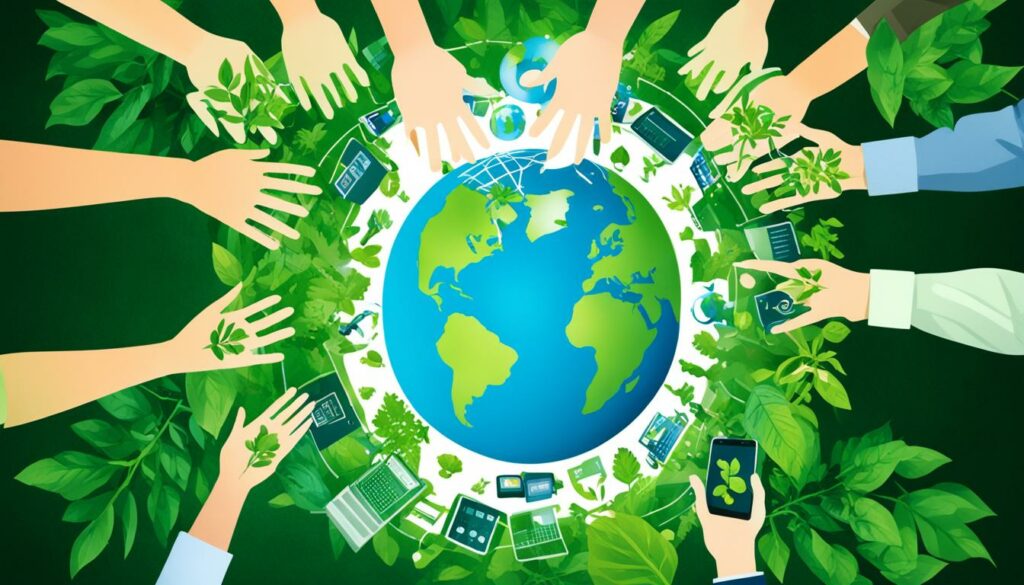
CERES, a group of universities, focuses on making our food supply chains better. By improving how we stop infections and quickly find threats, they make our food safer. Their work helps have more vaccines ready and makes food safety a priority.
At events like DialoguNEXT by the World Food Prize Foundation, over 250 groups met. They talked about how economics, policies, and learning can impact our food. This included speakers from key organisations who showed how sharing ideas can make supplying food more efficient.
Working together on a global level in farming is key to fight food security problems. President Biden signed a big order, NSM-16, in November 2022, showing how important it is for countries to work together. This order keeps American food supplies strong and safe through team efforts.
Programs like the Food, Agriculture, and Veterinary Defense work with the Plum Island Center to fight diseases across borders. Also, the U.S. Department of Agriculture and USAID’s join our food talks. Their teamwork at events like DialoguNEXT shows how important it is for governments to be active in solving food supply problems.
Furthermore, partners like ONL are working together in food and farming safety research. They focus on avoiding repetitive work and using resources well. This helps a lot in making our food safer and our ways of making food sustainable.
| Organisation | Role in Food Security |
|---|---|
| Coalition for Epi Response, Engagement and Science (CERES) | Promotes infection control and threat detection |
| World Food Prize Foundation’s DialogueNEXT | Facilitates discussions on economic impacts and policies |
| Plum Island Animal Disease Center | Conducts research on animal diseases |
| Food, Agriculture, and Veterinary Defense program | Develops countermeasures for animal diseases |
| ONL | Conducts R&D on food and agriculture security solutions |
Making food supply chains better through teamwork and smart partnerships is crucial. By bringing together skills from different areas and using new tech, we can make food more secure and sustainable.
The AgriTech world is facing big hurdles but also chances to grow and innovate. It’s interesting that despite its potential, the sector saw a 40% drop in venture capital. It went from $11.8 billion in 2022 down to $7.1 billion in 2023. This fall points to the challenges innovators and stakeholders face.
Uniting data from different sources is a major issue for the agritech sector. It needs solid data analytics for accurate farming. However, many traditional farms find it hard to adopt new tech due to lack of resources or resistance.
Big tech companies are trying to help, like Microsoft, Google, and AWS. They’re pushing for tech use through partnerships and new products. But, the problem of data integration continues.
A lot of help is needed to solve this problem. Google stated it has analysed 10% of the world’s farmland. This shows how crucial data is for increasing farm output. But, getting high-quality and reliable data is still hard, slowing down agritech’s chances for innovation.
Despite the challenges, there are still many chances for agritech to innovate. It’s moving towards technologies that fight climate change. These aim to make farming more sustainable by cutting down on water use, chemicals, and carbon.
The 2023 market shrink is expected to trigger lots of M&A activity in 2024. This could create new paths for growth. Yet, there are still challenges like regulations and the big need for funds. These are especially tough for smaller businesses and startups.
Given the competitive, global market, new and creative solutions are very necessary. Agritech faces the challenge of fighting new threats to crops. These threats come from globalization and climate change. This presents big opportunities for companies that innovate.
Looking ahead, teamwork between big tech, traditional farmers, and startups is key. Solving the data integration and regulatory issues will be crucial. This teamwork can bring in a new era of efficient and sustainable farming. It sets the stage for new, game-changing solutions in an ever-changing market.
The VISION Conference is a big deal for agriculture. It brings the top minds and doers together. They talk about new ideas and ways to help farming. This helps young people learn and grow in farming. It’s all about building a farming future that welcomes everyone.

The conference teaches a lot about farming’s future. It shows off new tech and how it’s used. A place like the Nonwovens Institute at NC State University stands out. It’s mostly funded by companies and has cool labs worth over $30 million. This kind of teamwork makes new ideas happen.
A special lesson is how important it is to get money from companies for farm research. The Nonwovens Institute gets about $5-6 million yearly from different groups. They use it to do cool projects that can actually help farmers. They also run programs with famous teachers that end up starting new businesses.
The conference really cares about young people learning about farming. Take the program that lets German students and teachers visit. It’s all about sharing skills and making friends from around the world. There are also spots for Ph.D. students to learn and grow. This is how they make sure the next farm leaders are ready.
Getting young ones who love tech to help in farming is very important. The VISION Conference talks a lot about this. They know young people can bring new ideas and also understand the latest technology. This is key for keeping farming smart and moving forward.
The VISION Conference doesn’t just talk about farming’s future; it helps make it happen. It’s all about sharing clever farm tricks and caring for the next farm leaders.
Space technology in farming is changing the game, bringing lots of advantages. It uses hyperspectral and optical satellite images to fine-tune farming. These tools help manage resources better and lessen harm to the environment. This encourages a healthier way to grow our food.
Hyperspectral images spot pests early, saving nearly 0.8 billion tonnes of crops yearly. They work with optical pictures to check on plant health. This lets farmers deal with crop issues directly, cutting the need for harmful chemicals and making farming greener.
This approach also reduces food wastage by a huge amount. It saves up to $175 billion for those who grow our food.
Knowing when, where, and how much water plants need makes a big difference. It saves about 2.8 billion litres of water yearly. This smart use of water also boosts how much crops grow and their quality.
Farmers save a lot of money, up to $8 billion, by using this technology. A study by McKinsey & Company sees its use growing by 10% each year. That could make the market for this technology reach $1 billion by 2030.
| Metric | Impact |
|---|---|
| Crops Salvaged | 0.8 Billion Tonnes Annually |
| CO2 Emission Savings | 50 Million Tonnes Annually |
| Water Saved | 2.8 Billion Litres Annually |
| Economic Value from Reduced Food Waste | $150-175 Billion |
| Grower Cost Savings | $7-8 Billion |
By using technology from space, farming becomes more efficient and kinder to our planet. Space tech helps farmers use resources better. This means they can grow more food while looking after the environment.
Technology plays a key role in making agriculture more resilient. It helps by predicting and lessening the impacts of natural disasters. These disasters are happening more often and are more severe. So, it’s important to have plans that protect the crops and the land. With the help of high-tech tools, farmers can plan better. They can reduce the damage from disasters and make sure there’s always enough food.
Natural disasters are a big threat to farms. Climate change is making the situation worse by shrinking the available farmable land. This affects our food supply, making it crucial to plan for disasters in farming. SERVIR, a program by NASA and USAID, uses satellite data to help. This data is used for better farming practices. For example, it helps farmers know the best times to plant and water their crops. This way, farmers can reduce the risks from bad weather.
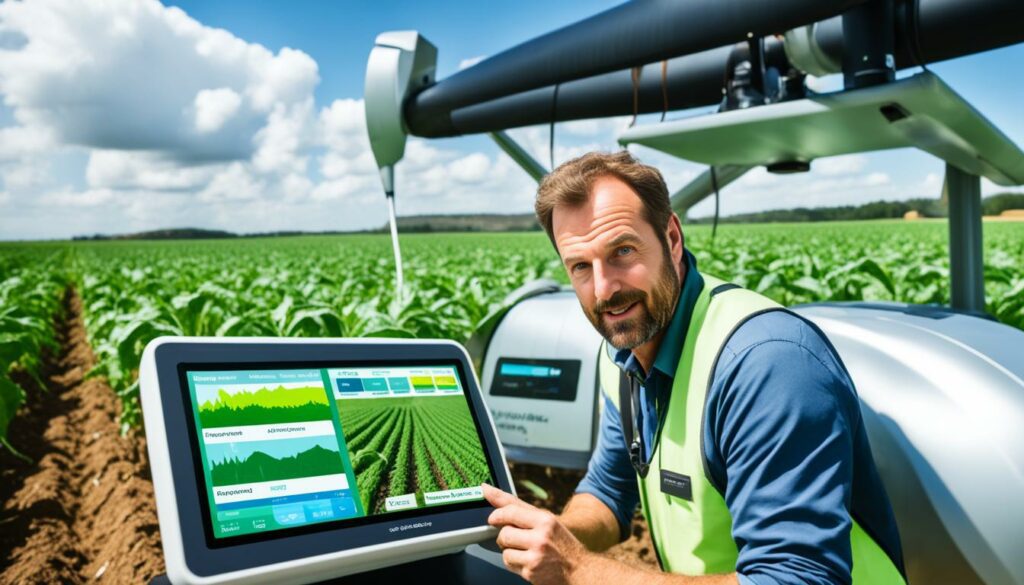
Today, farms need automation and constant checks to keep up. They use sensors, drones, and satellites to gather data faster. This data helps farmers make quick, smart choices. It also helps in looking after the soil and managing nutrients. By using these monitoring systems, farms can be more ready for changes. They become better at handling both money problems and issues in the environment.
Also, more and more farmers are using digital and precise tools. This is especially good for smaller farms. These tools help farms use their resources better. They also lower the pollution produced by farming. Using these tech solutions helps the agriculture sector deal with problems. It also makes sure the future of farming is sustainable. One good example is using satellite data for better nitrogen use. This leads to more crop with less harm to the environment.
In summary, technology is crucial for making farming more resilient and eco-friendly. By using automatic checks and smart farming plans, the agriculture field can tackle its problems. This includes managing challenges in farming today.
Collaboration between different industries is changing the farming world. This change is really obvious in places like Iowa. There, working together in different areas is making communities better. Research showed that everyone benefits from this, even if rural places have special struggles like less resources and being far apart.
Also, the coming together of food and medicine sectors is working really well. Big companies, such as Nestlé and Martek, are showing us how teaming up can make something entirely new. This mix of food and medicine tech is making new, healthier foods and better nutrition possible.
Moving ahead, agriculture’s success will depend on high tech and teamwork. For example, Syngenta teaming up with IBM is a big step in this direction. These kinds of partnerships help make farming more efficient and ready to meet the needs of more people. This path leads us to a future farming world where different fields working together make things better for everyone.
These collaborations link agriculture with other fields like tech and biotech. They aim to boost innovation and tackle problems together.
Technology is changing agriculture by making it more efficient and sustainable. It helps in saving resources, cutting down waste, and making smart decisions based on data.
Syngenta has teamed up with IBM Research and Maxygen. They’re advancing farming with new predictive models, better chemicals, and improved proteins.
Satellites warn about pests, improve crops, and keep an eye on farms. They provide tools for better farming, using less and protecting our planet.
AI and Big Data help farmers by offering smart analyses and predictions. These tools are used to make better chemicals and improve farming methods.
Start-ups and small tech firms bring fresh ideas to farming. They offer new solutions which are showcased by projects like Syngenta’s Shoots.
Sustainable projects aim for lasting health and strength in farming. For example, Maxygen works on better proteins and using waste to create green materials.
New tech analyses growing conditions and monitors crops in real-time. This helps farmers make better choices that lead to higher crop yields.
It’s farming that heals the soil and the planet. The goal is to make soil better, increase life diversity, and build strong farming systems.
These partnerships are set to grow, giving benefits to all involved. They will keep bringing new solutions, solving farming issues, and promoting green methods.
By working together, they can produce more food and make its delivery smoother. The Shoots platform from Syngenta is a good example of this effort.
AgriTech faces issues with data handling but presents great chances for growth. Solving these problems can lead to exciting changes in the sector.
The VISION Conference encourages varied groups to work together. It shows how tech, teamwork, and young minds can push farming forward and solve upcoming challenges.
Space tech can improve how water is used, lower pollution, and better monitor crops. This helps make farming more sustainable and effective.
By predicting and preventing disasters, technology gives farmers more control. It allows them to run their farms smarter and more prepared for the future.